Interview with Mai Tanaka, the author of the anime 'I Became a Teacher at a Yokai School!' The comedy route recommended by an editor worked perfectly, and her first serialized work became a long-running series that ran for over 10 years and was made into an anime

The anime ' I Became a Teacher at a Yokai School! ' (Yokai Hajime) began airing in October 2024. It depicts the daily lives of Abe Haruaki, a teacher who is assigned to a 'school for yokai, by yokai, and about yokai,' and his unique students. The series is based on a manga by
Official website for the TV anime 'I've Become a Teacher at a Yokai School!'
https://youkaigakkou.com/
Mai Tanaka, who agreed to the interview (self-portrait).
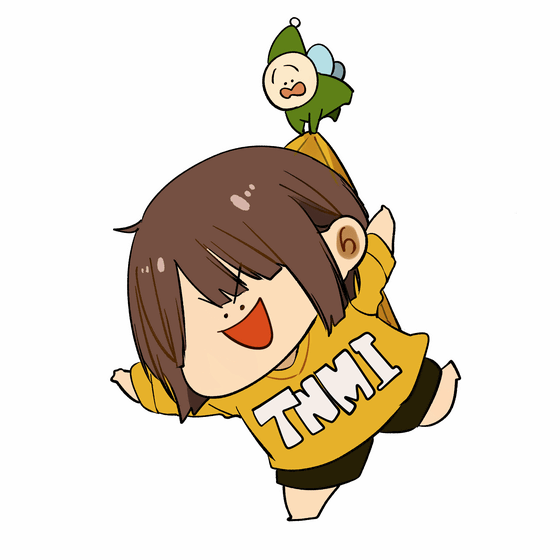
GIGAZINE (hereinafter, G):
When I read this work, 'Yokai Haji,' I thought, 'The exchange of jokes and retorts unfolds at an incredible pace within a single page.' How long do you spend on creating a storyboard for each episode?
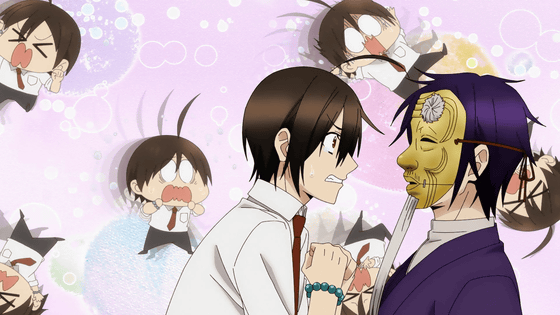
Mai Tanaka, author of 'I've Become a Teacher at a Yokai School!' (hereinafter, Tanaka):
There is a huge difference between when I can and when I can't. When I can, I sometimes draw all at once in about half a day.
G:
Half a day! So fast!
Tanaka:
But sometimes it takes two weeks or so to complete something. Sometimes I'll say 'I can't do it' up until about a week before the deadline (laughs).
G:
That's crazy (laughs) It's quite a range, but when does that difference appear?
Tanaka:
When I can do it in half a day, everything is ready in my head, from the beginning to the end to the content of the conversation, and I just have to draw it. However, there are times when the story flow is ready but I have to draw the jokes on the spot... It's like 'I've decided which mountain to climb, but I haven't made a plan for how to climb it.'
G:
'I didn't make any mountain climbing plans'! (laughs)
Tanaka:
It takes a lot of time if you get lost in the middle of a climb, or go around in circles and wonder 'Huh? Where is the goal?' But if you have a perfect climbing plan, you can climb with ease.
G:
'Yokai Hajime' has been serialized for 10 years, but what is the ratio of 'can do' to 'can't do'?
Tanaka:
It's 9 to 1 and I can't do it (laughs). There are more times when it's difficult.
G:
When I read the finished work, I felt completely confused and wondered 'How can someone create something like this?' and thought 'If he's been drawing this for 10 years without any trouble, that's incredible...', but I was somewhat relieved to hear that it must have been quite difficult for him.
Tanaka:
No, no, it's really hard. I have to add hints as I draw, so I'm always thinking, 'What should I do?'
G:
When I re-read the first volume, there were lines that connected to later parts and I thought, 'Oh, so that's what it was!' Did you think carefully about what would happen later on in the beginning? Or did you think, 'I'll connect this part like this' as you were drawing?
Tanaka:
As for the storyline, some parts are pretty set in stone, and some longer stories have taken around five years to come up with, so there are episodes where I feel like I need to lay the groundwork for that.
G:
In this work, a bunch of classmates appear from the beginning, and their secrets are revealed little by little along the way. Were these settings decided in detail from the time the work was first released?
In the anime, unique students make their appearance from the first episode.
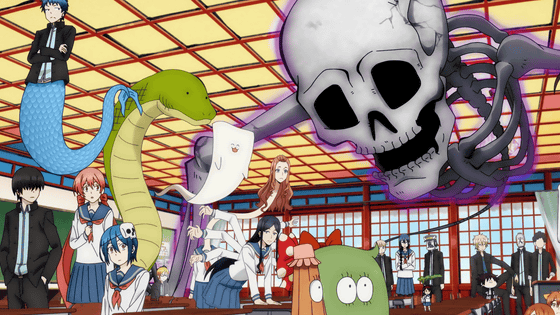
Tanaka:
To be honest, very little had been decided (laughs). Aside from a few main characters, there were some characters whose settings I wrote down in just two or three lines.
G:
Ah, so in that case, there were some characters whose appearance was the only thing that was decided at first.
Tanaka:
That's true. I drew about five characters on each A4 sheet of paper, and sent them to the editor, saying, 'These are the characters.'
G:
Didn't your editor point that out to you?
Tanaka:
I'm really good at expanding characters. Even if I start with little information, I'm good at creating a character that has consistency.
Attractive students

G:
Do you feel like each character develops well as the series progresses?
Tanaka:
There is a hell of a lot of it.
G:
As I was reading, I noticed that even the characters that appeared from the beginning didn't have any personality flaws, and the tone of voice and what they were saying were all pretty consistent... I thought, 'If they were thinking about it midway through, there would be some inconsistencies.'
Tanaka:
There are quite a few parts where I was drawing at the same time (laughs).
G:
Could it be that 90% of the episodes are difficult because you have to take these aspects of the characters into consideration when writing the names?
Tanaka:
That's very true. There are times when I'm like, 'I have to include this plot point by this episode, so I have to include a conversation between this character and this character by then, so where should I put it...'
G:
Wow... Every story ends with a good twist, at a good point, but I wonder if the degree of struggle with 'what should I do in the last panel' is different between the 10% of episodes that are easy and the 90% of episodes that are difficult.
Tanaka:
Ah, not at all.
G:
!?
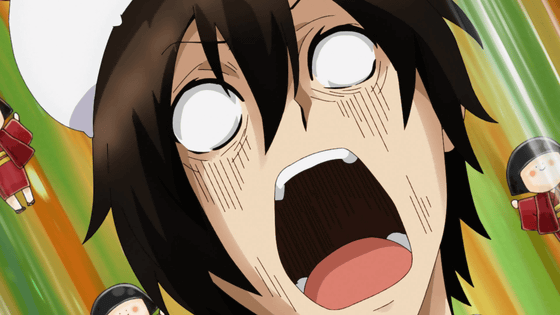
Tanaka:
When I think about a story, I'm the type of person who starts by thinking about the end.
G:
So the name also comes from the end?
Tanaka:
That's right. The first thing I start drawing is the ending, the punch line, so I don't really have any trouble with that.
G:
Ohhh... I understand what you're saying, but... has the final scene been decided specifically? Or is it just a general idea of how the story will go?
Tanaka:
It's a little different between one-shot episodes and feature-length episodes, but with feature-length episodes, I'll divide them into sections by saying, 'This is the end, so I'll draw from here.' I start by thinking about the ending of the main story, and then I think about how to reach that ending.
G:
I see, that's how you think about it. In fact, even after reading the manga and talking to you about it, I still feel like 'it's not going to be like that' (laughs). Tanaka commented on the first volume, 'It's my first full-scale serialization, my first book, my first monster story, my first full-on comedy, and it's all new to me, so I'm shaking like a newborn fawn.' Why did you decide to draw a monster comedy?
Tanaka:
This was due in large part to the opinion of my editor at the time. I had always drawn serious shounen manga before I started drawing 'Yokai Haji', but my editor advised me, 'Since dialogue is interesting, it will sell better if you do a comedy.' I had never drawn a comedy before, and I can make funny things happen in natural conversations, but when I was asked to 'draw a work that makes people laugh,' he said, 'That's impossible,' and it became like a back-and-forth argument. In the end, I thought, 'Let's give it a try,' and I was given the opportunity to do a short, intensive serialization before this work, and I think that was a big factor.
G:
Is that so? When I was talking to you this time, I looked at your past posts on social media, and I saw a story about how a character you drew in a notebook when you were a junior high school student became a serialized character 10 years later, and finally became an anime. What kind of manga were you drawing?
A manga character I drew in my notebook when I was in middle school became a serialized manga character 10 years later, and then an anime character 10 years later 🥹 It's quite moving... https://t.co/kpP2owZrFj pic.twitter.com/ZzklD3EKk6
— Mai Tanaka ◎ Yokai Hajime anime adaptation confirmed! (@tanamai78) August 13, 2024
Tanaka:
This was a hardcore adventure fantasy. I think it would be classified as a 'reincarnation in another world' story today. I kept drawing it in my campus notebook.
G:
Did you start drawing manga when you were in middle school?
Tanaka:
I've been drawing the manga in my notebooks since I was in the first grade of elementary school, and I continued working on this piece over a period of six years, from the sixth grade of elementary school to my third year of high school.
G:
If he continued drawing for six years, that must be an enormous amount of work...
Tanaka:
Yes, it was a 100-page notebook.
G:
And it's thick!
Tanaka:
I have dozens of them, and they are still kept at my parents' house.
G:
I would love to read it. I'm sure everyone would want to read it, wondering what on earth it was about.
Tanaka:
Now that I think about it, it was a manga that was typical of middle school students, and had some typical 'Chuunibyou' (chunibyo) elements (lol).
G:
Did you show it to your friends and get their feedback?
Tanaka:
I never showed my work to anyone. It was all for my own satisfaction, and I just kept drawing for my own enjoyment.
G:
Draw it yourself, read it yourself?
Tanaka:
So I was laughing out loud. Honestly, I had never thought about 'having people read my manga' until I had my own serialization.
G:
When I read 'Yokai Haji,' I felt it was a work full of the spirit of offering something special, so I connected it to the fact that you started drawing manga when you were in middle school, and thought maybe it was because a lot of people had been reading your work since back then, but it's actually the opposite.
Tanaka:
It feels like I've always had thoughts like, 'If something happened to me, I'd be happy,' or 'It would be nice if a scene or development like this occurred.'
G:
X also published a manga that he had drawn a long time ago using a notebook he had dug out of his closet.
Wow!! I even found the first manga I ever drew!! They even kindly included the date! (;▽;)2008...
— Mai Tanaka ◎ Yokai Hajime anime adaptation confirmed! (@tanamai78) November 4, 2015
I wanted to see the whole thing again, but I was disappointed that there was only this one picture _(:З」∠)_ pic.twitter.com/UEcq9o2I7J
Tanaka:
This was the first manga I ever brought to school. It was the first time I drew a manga on manuscript paper after entering vocational school.
G:
Do you remember what they said to you when you brought it in?
Tanaka:
First of all, 'I understand what you want to draw, but the picture doesn't keep up.'
G:
That's pretty blunt...
Tanaka:
After that, I took my work to other places, but I was often told the same thing about my drawings. I was told repeatedly to improve my drawings rather than the story, so I felt like I had no choice but to practice my drawings.
G:
Jumping ahead to 2024, you posted that you were unable to use a perspective ruler and had to be taught how to use it. Does this mean that you continued to draw using analogue methods until fairly recently?
Hikaru Tanaka-sensei has been helping me with the manuscripts for Yokai Hajime even while she is still serializing her own manga.
— Mai Tanaka ◎ Yokai Hajime anime adaptation confirmed! (@tanamai78) May 29, 2024
I couldn't use a perspective ruler and had been drawing backgrounds with a ruler on a liquid tablet until last month, but he invited me to his house and taught me how to draw digital backgrounds directly. He's a really amazing person.
I hope many people will read this new series by Tanapika-sensei.
Tanaka:
Even the line drawings for the bath episode, the final chapter of volume 4 of 'Yokai Hajime,' were done analogue.
G:
Was that around the time you realized you had to switch to digital?
Tanaka:
I once tried to draw fully digitally in episode 15 of volume 3, but it didn't go over well with the editor, so I only did it for one episode and thought, 'I need to practice this,' so I practiced digitally behind the scenes while drawing the manuscript analogically until the end of volume 4. Then, when I drew the bath episode half analog and half digital, no one pointed out anything strange about it (laughs).
G:
I didn't notice (laughs)
Tanaka:
So from the beginning of Volume 5, Chapter 25 onwards, it became fully digital.

G:
You mentioned that the thing you got the most praise for from your family and friends about 'Yokai Haji' was 'the unexpected title.' What kinds of titles did you consider?
Come to think of it, the thing I got most praise for from my family and friends about the book was actually the title...!
— Mai Tanaka ◎ Yokai Hajime anime adaptation confirmed! (@tanamai78) June 15, 2015
I racked my brains over the title for over a month, with close to 100 title ideas disappearing into the darkness. Towards the end, it even appeared in my dreams, so I'm really happy to be praised for it (´;ω;`)
But for some reason, no one touches the inside (・ω・) No touching!
Tanaka:
To be honest, there were so many things I mentioned that I can't even remember them all (laughs). I had a lot of ideas centered around monsters, and the main character, Haruaki, was inspired by Abe no Seimei, so I thought it might be better to make him more of an onmyoji (exorcist), and since I've been doing shounen manga up until now, there were a lot of titles with a serious feel to them. There weren't many that had a comedy feel to them.
The protagonist, Seimei
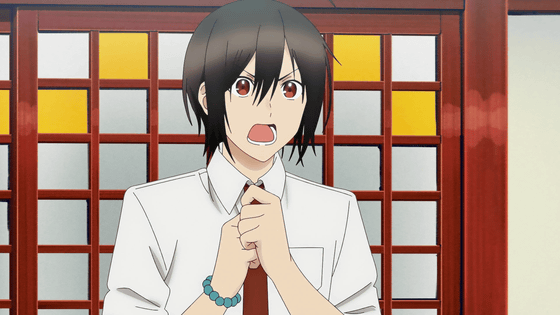
Tanaka:
But among them, there was one that I thought was a bit too silly, but the editor said it was good (laughs).
G:
You've talked about when you decided to become a manga artist on social media, saying that you started aiming to become one when you were in elementary school because you thought that becoming a manga artist would help you improve your drawing skills.
Tanaka:
When I was in elementary school, my classmates would often criticize me for being bad at drawing. I've always loved making stories, and I was always thinking about consistency, but I wasn't good at drawing to express that well, so I thought, 'Well, maybe if I become a manga artist I'll be able to draw well.' Of course, as I continued to draw in my lower and middle years of elementary school, I realized, 'This is the opposite, isn't it?' (laughs)
G:
That's good (lol)
Tanaka:
My thoughts shifted towards, 'I can't become a manga artist unless I get better.'
G:
You said that you started drawing on manuscript paper after you entered vocational school, but how many works have you drawn so far? On SNS, you have drawn 12 characters as the main characters.
I started drawing manga on manuscript paper in earnest at 19, and it's been about five years since then, so I lined up all the main characters I've drawn so far! (;▽;) Gathering them all together again brought back memories from the past five years! I have a special attachment to each one! (´;ω;`) pic.twitter.com/VX4prASpcL
— Mai Tanaka ◎ Yokai Hajime anime adaptation confirmed! (@tanamai78) April 4, 2014
Tanaka:
It's more than 12 works, I drew more in my spare time. It took me a long time to make my debut, and the main reason was that my drawings couldn't keep up with what I wanted to express. I submitted nearly 10 works before winning the manga award.
G:
It would be difficult to bring it in 10 times unless you're mentally very strong.
Tanaka:
I think it was tough. But the only thing is that I wasn't often told 'You should do the story like this,' so I had hope that 'If I keep drawing, it will work out,' and I got through it with the mentality that I just had to keep drawing as much as possible.
G:
You said that you were drawing shounen manga up until 'Yokai Hajime,' but what kind of style did you draw most of? Was it different each time?
Tanaka:
There were a lot of battle manga. However, now that I think about it, there weren't many comedy elements, and they didn't have any strong characters.
G:
And so 'Hotoke-san of the Pure Land' was the first work to be published in 'Monthly G Fantasy.' Did you feel that your sense of your work had become more refined by this time?
Tanaka:
Up until this work, I had been working on a different boys' manga magazine, but from here on, I was publishing in 'Monthly G Fantasy,' which meant that the magazine was mainly aimed at female readers, so I had to do something about my drawings and become able to draw cool boys. Since I was going to be working in a magazine called 'G Fan,' which has a lot of beautifully drawn works, I felt pressured to draw beautifully as well. I practiced drawing a lot around this time.
G:
I see. And so, you decided to publish 'Karma Karma' as a short-term intensive serialization. This is the comedy route that you mentioned earlier, and you decided to try it out.
Tanaka:
That's right. It was from this work that I began to understand the direction I was heading in, and I realized that even in a comedy, 'I can make it interesting this way,' and that 'if I create an introduction, development, twist, and conclusion, the story will flow nicely.' It was from this work that I was able to do that.
G:
I understand that 'Karma Karma' was your first attempt at a comedy film. What were the challenges you faced in taking the comedy route at first?
Tanaka:
Actually, I didn't have any difficulties at all once I decided to write a comedy.
G:
Huh...?
Tanaka:
Basically, it was just as my editor had said, and when I started drawing it, I thought 'this is fine' (laughs).
G:
That was the keen insight of the person in charge.
Tanaka:
That's right. I realized that it was possible after I tried drawing it, and I was able to start 'Yokai Hajime' with confidence.
G:
Wow, so that's how it is. When I read 'Yokai Haji,' I thought he was an author who had already written two or three such works and was familiar with them, but when I read the comments at the end of the volume, I saw that it was all his first time, so I was like, 'Huh?'
Tanaka:
I'm able to take on 'Yokai Hajime' knowing that it's really okay to do whatever I want.
G:
Looking around, it seems like you go on quite a few reporting trips, so does that mean you travel a lot?
This year was a year of Yokai Wars, with the release of a new volume of P-Haji for the first time in several years, the 100th chapter, a trip to Meiji Village with my editor to do some research and starting the Meiji Love Story arc, the release of various goods, and finally the announcement of an anime adaptation. It was truly a year of Yokai Wars, both above and below the surface! 🥰
— Mai Tanaka ◎ Yokai Hajime anime adaptation confirmed! (@tanamai78) December 31, 2023
We will do our best to make next year full of Yokai! Thank you for your continued support!
Tanaka:
I think it's a lot. I think it's the first time I go if there's a feature-length story of three or more episodes that takes place somewhere other than school.
G:
So that's how it is.
Tanaka:
I've always loved buildings, and I often create stories based on photos of buildings and backgrounds. For example, the story about the school trip in volume 5 has an abandoned school as its motif, but there is a place where you can actually go inside.
G:
I thought it looked incredibly realistic, was there a model for it?
Tanaka:
In fact, I was able to get permission to enter, and the moment I entered the building, I immediately had an image of Seimei and the others running down the hallway, so I started thinking about the story from there.
G:
oh.
Tanaka:
During the Kyoto edition, I went to Kyoto, took photos for about 30 minutes, and then turned around and came back to Tokyo. I wanted to go to Yasaka Shrine, so I just went to Yasaka Shrine and took a bunch of photos.
G:
Well...I saw a post on social media about someone going bungee jumping, and I was intrigued, and wondered why they were bungee jumping here, but maybe...
3.2.1 Bungyyyyyyy (ノ`・ω・´)ノ
pic.twitter.com/waTBT0d6Qi — Mai Tanaka ◎ Yokai Hajime anime adaptation confirmed! (@tanamai78) August 26, 2014
...I seriously thought I was going to die ( ´;ω;` )
Tanaka:
Anyway, I want to try various experiences. I'm scared of heights, so I don't really want to do bungee jumping, but I want to try it anyway. I have a nature where I want to experience something if I have to try it. Also, I have a friend in my hometown who loves B-class spots, and if he tells me about an interesting building, I'll go there that same day.
G:
I see... so 'Yokai Hajime' was built on the support of such experiences.
Tanaka:
That's absolutely true. The class of Year 2-3 itself is based on the atmosphere of the class I was in when I was in third year of middle school, so I think there are quite a few parts that are based on my own experiences.
G:
I thought it was a work that seemed absurd but had a solid sense of reality, and there was a good reason for that. I've asked you a lot of questions, but it's almost time, so please give a message to those who have learned about 'Yokai Hajime' through the anime that started in October 2024 or this interview and are thinking of reading it.
Tanaka:
As you said, there are some parts that seem absurd, but there are also some realistic parts, and some fantasy. It's a work that's full of various elements and can be enjoyed by a wide range of people. You can enjoy it as a comedy or as a serious piece, so I hope you'll enjoy it from various perspectives, so I hope you enjoy it.
G:
Thank you for today.
Tanaka:
Thank you very much.
The manga 'I've Become a Teacher at a Yokai School!' is currently being serialized in the monthly G Fantasy magazine, and 17 volumes have been published so far.
Amazon.co.jp: I Became a Teacher at a Yokai School! (17) (G Fantasy Comics): Mai Tanaka: Books

The spin-off work, 'I've Become a Student at a Yokai School!', is also written by Tanaka, and two volumes have been published so far.
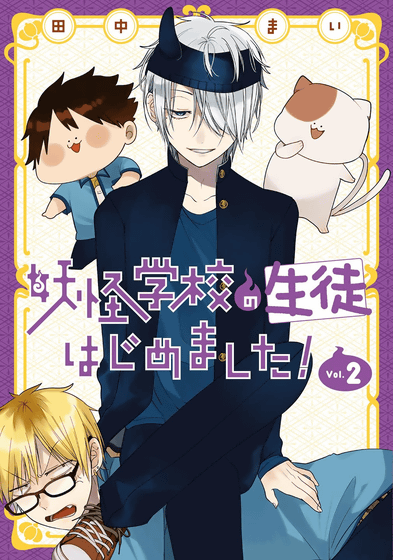
The anime 'I Became a Teacher at a Yokai School!' will begin broadcasting and streaming on Tuesday, October 8, 2024. It will air on TOKYO MX every Tuesday at 11pm, on ABC TV every Wednesday at 1:14am, and on BS Asahi every Sunday at 11pm. It will also be streamed on various sites, including ABEMA and d Anime Store. It is a two-season series, so please take your time to enjoy it.
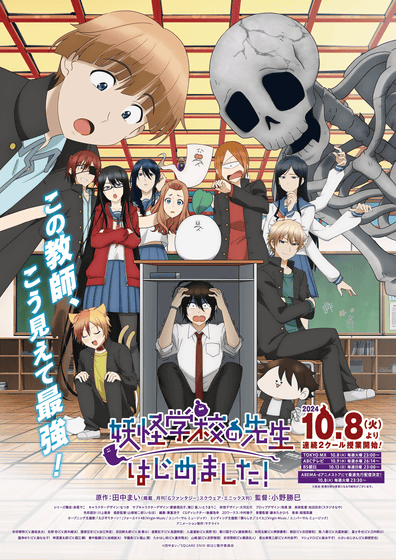
The non-credited opening and ending footage is available on YouTube.
TV anime 'I started teaching at the Yokai School!' Non-credit opening - YouTube
TV anime 'I started teaching at a yokai school!' Non-credit ending - YouTube
©田中まい/SQUARE ENIX・妖はじ製作委員会
Related Posts:







